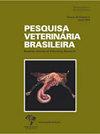山羊对红毛豆中毒的易感性
IF 0.8
4区 农林科学
Q3 VETERINARY SCIENCES
引用次数: 0
摘要
摘要:在巴西东北部半干旱地区,仅报道了绵羊自发性和实验性的灰毒。病理上,这种中毒可导致腹水和小叶中心肝纤维化。然而,这些影响需要在山羊身上进行实验研究。本研究旨在确定山羊对灰葡萄球菌的易感性和最小毒性剂量,描述主要临床和解剖病理结果。实验中,一只绵羊接受了每公斤10g的地面植物,两只山羊接受了每公斤5g剂量的地面植物,第二只接受了每公斤10g剂量的地面植物。试验第50天,羊开始进食后第34天出现腹胀,出现胸骨卧位、呼吸困难、斜拉肌、下颌咬合、流涎、吞咽困难、发声和蹬车动作。尸检发现腹腔和肝脏有积液,包膜表面不规则,微白色。组织学上,肝脏的主要病变为中度纤维化,明显的窦性扩张,伴有明显的出血,有时在小叶中心区域之间形成桥,与肝细胞索分离有关。神经系统枕叶皮层灰质中存在离散的阿尔茨海默病II型星形胶质细胞。山羊2表现出冷漠、嗜睡和体重下降;第62天,侧卧演变为胸骨卧,颈部向侧腹旋转。尸检时,面部、皮肤明显水肿,有少量积液;腹腔内见微黄色物质。肝脏包膜表面有离散的变黑区。组织学上,肝脏表现为轻度小叶中心纤维化,伴轻度肝细胞索解离和轻度肝细胞质空泡变性。山羊1无临床症状;尸检时,在肝脏包膜表面观察到离散的多灶区。组织学上可见肝细胞弥漫性胞浆内空泡变性。不同物种的临床表现和解剖病理结果不同,证明山羊对灰带绦虫的易感性较低(与绵羊相比),在中毒的发病机制和流行病学方面存在差异。本文章由计算机程序翻译,如有差异,请以英文原文为准。
Susceptibility of goats to poisoning by Tephrosia cinérea
ABSTRACT: Spontaneous and experimental poisoning by Tephrosia cinerea in the northeastern semiarid region of Brazil has only been described in sheep. Pathologically, such poisoning leads to ascites and centrilobular liver fibrosis. However, these effects require an experimental study in goats. This study aimed to determine the goats’ susceptibility to the ingestion of T. cinerea and the minimum toxic dose, describing the main clinical and anatomopathological findings. Poisoning was reproduced experimentally in one sheep that received 10g/kg of the ground plant and in two goats, the first receiving a dose of 5g/kg and the second receiving 10g/kg of the ground plant. The sheep presented abdominal distension 34 days after beginning the ingestion of the plant, developing sternal decubitus, breathing difficulty, opisthotonos, mandibular trismus, salivation, dysphagia, vocalization, and pedaling movements on the 50th day of the experiment. Fluid accumulation was observed in the abdominal cavity and liver via necropsy, with an irregular, slightly whitish capsular surface. Histologically, the main lesions observed in the liver were moderate fibrosis, marked sinusoidal distension, accompanied by marked hemorrhage, sometimes forming bridges between the centrilobular regions, associated with a dissociation of hepatocyte cords. There were discrete Alzheimer’s type II astrocytes in the gray matter in the region of the occipital cortex in the nervous system. Goat 2 showed apathy, drowsiness, and weight loss; on the 62th day, lateral decubitus evolved to sternal decubitus, with a rotation of the neck towards the flank. At necropsy, marked edema was observed on the face and dewlap, and a slight accumulation of liquid; slightly yellowish material was observed in the abdominal cavity. There were discrete blackened areas on the capsular surface in the liver. Histologically, the liver showed mild centrilobular fibrosis associated with mild dissociation of hepatocyte cords and mild vacuolar degeneration of the hepatocyte cytoplasm. Goat 1 showed no clinical signs; at necropsy, discrete multifocal areas were observed in the liver on the capsular surface. Histologically, diffuse intracytoplasmic vacuolar degeneration of hepatocytes was detected. The clinical picture and anatomopathological findings differ between the species, proving the lower susceptibility of goats to Tephrosia cinerea ingestion (compared to sheep), with differences in the pathogenesis and epidemiological aspects of poisoning.
求助全文
通过发布文献求助,成功后即可免费获取论文全文。
去求助
来源期刊

Pesquisa Veterinaria Brasileira
农林科学-兽医学
CiteScore
1.30
自引率
16.70%
发文量
41
审稿时长
9-18 weeks
期刊介绍:
Pesquisa Veterinária Brasileira - Brazilian Journal of Veterinary Research (http://www.pvb.com.br), edited by the Brazilian College of Animal Pathology in partnership with the Brazilian Agricultural Research Organization (Embrapa) and in collaboration with other veterinary scientific associations, publishes original papers on animal diseases and related subjects. Critical review articles should be written in support of original investigation. The editors assume that papers submitted are not being considered for publication in other journals and do not contain material which has already been published. Submitted papers are peer reviewed.
The abbreviated title of Pesquisa Veterinária Brasileira is Pesqui. Vet. Bras.
 求助内容:
求助内容: 应助结果提醒方式:
应助结果提醒方式:


